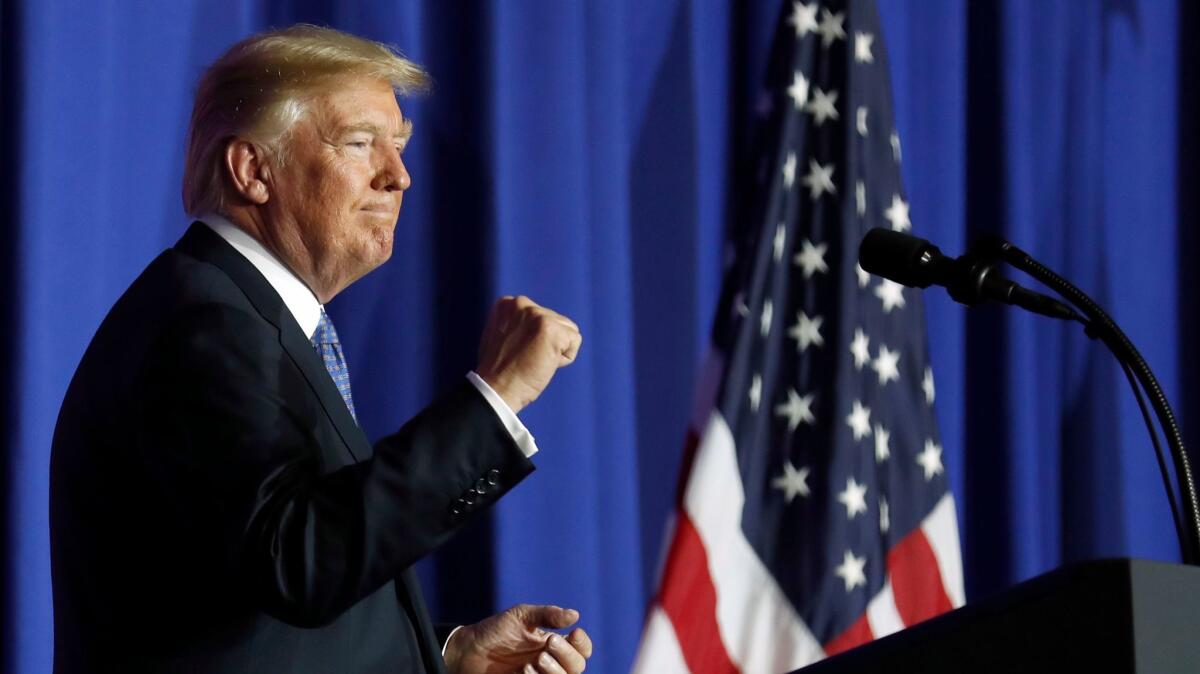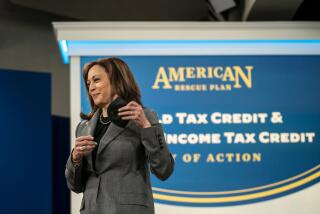Tax breaks aimed at small businesses may favor a sliver of wealthy owners

When Republicans rolled out their tax reform proposal this week, President Trump highlighted a provision aimed at the vast majority of small and family-held enterprises.
Under the tax plan, which Republicans say is meant to simplify a Byzantine code and promote business investment, sole proprietors, partnerships and so-called S corporations would see their top tax rate dropped from 39.6% to 25%.
The change is meant to help so-called pass-through businesses, which include mom-and-pop shops, restaurants, law firms, hedge funds and other large partnerships that pay taxes based on the individual tax code.
But tax experts said the biggest beneficiaries would be a small minority of wealthy business owners. And the changes, they said, are likely to complicate matters further by fueling a rush among well-off professionals to reclassify themselves as pass-through firms to shirk a maximum 35% personal rate.
âThere is going to be big shenanigans,â said Gonzalo Freixes, a professor of taxation at the UCLA Anderson School of Management.
Businesses structured as corporations are taxed at a rate of 35%, which the Trump plan would cut to 20%. Dividends those corporations pay to their shareholders are then taxed again.
But about 95% of American companies â including some of Trumpâs own businesses â are structured as sole proprietors, partnerships and S corporations, according to the Brookings Institution. For these companies, profits simply âpass throughâ to owners, and are taxed at individual rates.
The top tax rate for individuals and such businesses stands at 39.6%. The Republican proposal would drop the personal rate to 35%, though it leaves the door open for Congress to add a higher rate.
Trump, in a speech in Indiana on Wednesday, said the pass-through provision would help âmillions of small businesses and farms.â
âThis will be the lowest top marginal income tax rate for small and mid-size businesses in this country in more than 80 years,â Trump said.
The outline, released Wednesday, says that the plan âcontemplatesâ lawmakers âwill adopt measuresâ to prevent wealthy people from recategorizing personal income as business income to take advantage of the new, low pass-through rate.
For example, experts say lawmakers will have to devise rules to stop engineers who make $200,000 in salary from classifying themselves as a limited liability company that their same employer would then hire.
Rules will also have to lessen the incentive for business owners to pay themselves less of a salary and argue the remainder of their haul comes from the business and not as a reward for their individual labor.
âThey are both huge problems and would generate large revenue losses,â said Katie Pratt, a tax professor at Loyola Law School.
Gary Cohn, the top White House economic advisor and former president and chief operating officer of Goldman Sachs, said Thursday the administration has established âlanguageâ to prevent abuses, though it hasnât been released.
âThe last thing we want to see is wealthy individuals or wealthy groups or families move their tax rate down from the 35% rate to the 25% rate,â Cohn said. âWeâre acutely aware of that. Guys like myself should not be allowed to put their assets into a partnership and reduce their tax liability by 10%.â
The last thing we want to see is wealthy individuals or wealthy groups or families move their tax rate down from the 35% rate to the 25% rate.
— Gary Cohn, White House economic advisor
Crafting rules to prevent abuses is difficult, tax experts said, noting an entire industry is devoted to helping companies and individuals achieve the lowest possible rate.
âAll the tax lawyers just laugh,â Pratt said. âItâs extremely hard to prevent.â
Earlier this month, Treasury Secretary Steven T. Mnuchin told CNBC that âservices companies that are pass-throughs will not get the benefit of the rate.â
âIf you are an accountant firm and thatâs clearly income, youâll be taxed at income rates. You wonât be taxed at pass-through rates,â he said. Mnuchin suggested manufacturing companies would be treated differently.
âIf you are a business thatâs creating manufacturing jobs, youâre going to get the benefit of that rate, because thatâs going to be passed through to help create jobs and better wages,â he said.
Pratt, the Loyola law professor, said service businesses at times have been defined to include doctors and lawyers. But she said itâs unclear whether Mnuchin meant all service businesses would be barred from the lower rate or if they would be subjected to heightened scrutiny.
A Treasury spokeswoman did not return emails seeking clarification, and a White House spokesperson said it will be up to congressional committees to decide specific anti-abuse rules.
One of the stated goals of the Republican plan is to help business owners create jobs by freeing up more money to invest.
Thatâs exactly what Los Angeles attorney Kenneth Reyes said heâd do if he got a break.
Reyes, who specializes in divorce law and employs three attorneys and a paralegal, structured his firm as an S corporation. Most recently, he said, heâs paid the top 39.6% rate.
He estimated heâd save around $70,000 if the rate dropped to 25%.
âI could use it for advertising and to hire more associates,â Reyes said.
Of course, business owners could also choose to pocket that money.
Many businesses may not make enough money to benefit from the pass-through rate.
According to an analysis by the nonpartisan Tax Policy Center, 86% of the 38 million households with pass-through business income already pay a tax rate of 25% or lower â meaning they wouldnât benefit from reducing the cap to 25%.
Under the current code, the 25% bracket tops out at income of $153,100 for a married couple and $91,900 for a single filer.
The Tax Policy Center said 670,000 households pay the top 39.6% rate on business income, or 1.8% of all those reporting pass-through income.
The top bracket â which stands to benefit the most from the change â currently kicks in for income of over $470,700 for a married couple and $418,400 for a single filer.
âThe vast majority of the overall benefit goes to the the top 1%,â said Michael Linden, a fellow at the left-leaning Roosevelt Institute.
However, a White House spokesperson said business owners of more modest means would see a reduction in their taxes because of changes to personal rates under the larger proposal. Those business owners would benefit from a âreduction of the 15% rate to 12%,â as well as other changes, the spokesperson said.
Any analysis of the tax planâs winners and losers is made difficult by the fact that so many of the specifics remain to be hammered out by Congress.
For example, the proposal envisions fewer tax brackets for personal income but doesnât define the income thresholds.
Edward Kleinbard, a USC professor and former chief of staff to Congressâ Joint Committee on Taxation, said setting different rates for corporations and varying kinds of pass-through businesses raises questions about the policy objective the government wants to achieve.
âThere is no logic here,â Kleinbard said. âI donât know why a corner Thai restaurant is inherently better than a ⌠law firm.
âThis will be a gold mine for tax lawyers for decades to come,â he said.
Times staff writer Jim Puzzanghera contributed to this report.
Follow me @khouriandrew on Twitter
ALSO
Equifax interim CEO apologizes for bad customer service after data breach
Hereâs why Trumpâs tax plan will hit Californians especially hard
More to Read
Inside the business of entertainment
The Wide Shot brings you news, analysis and insights on everything from streaming wars to production â and what it all means for the future.
You may occasionally receive promotional content from the Los Angeles Times.











